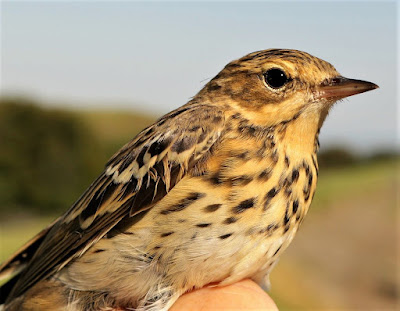There’s no birding or bird ringing for a day or two with both rain and wind preventing activities.
However, there came an interesting if slightly puzzling recovery of Lesser Redpoll AJD6136.
We caught and ringed redpoll AJD6136 at Oakenclough on the morning of 1st October 2018. The morning produced a catch of 6 Lesser Redpolls, 4 Goldfinch, singles of Chaffinch and Meadow Pipit, plus a couple of Great and Blue titmice; a typical if not over large mix of early October local and migrant species.
At this time of year many Lesser Redpolls from Northern England and Scotland are on their way south to winter in France and the hotspot of Belgium, the latter a country with a special attraction to the species. A Belgian winter landscape holds a redpoll's preferred seeds in abundance and the ambient temperatures are certainly preferable to those of Scotland.
Lesser Redpoll from BTO Migration Atlas
“Most recovery data of Lesser Redpolls comes via North and North West European ringing regions. Most populations follow on average a North to South or North West to West/South East axis, with recoveries as far as N Kazakhstan, up to China. There are two recoveries at more than 4000 km, mostly less than 2000 km.” BTO.
Only this week did we learn that the same Lesser Redpoll AJD6136 was recaptured by Belgian ringers 44 days later at Maubray, Hainaut, Belgium on 18th October 2018. Yes, that’s right; it took four years for the information to reach us that AJD6136 was recaptured in the centre of the Belgium hotspot pictured above.
A likely but only partial explanation for the four year delay is that the Belgian end of the recovery noted the ring as AJO6136 rather than AJD6136, transposing the letter “D” as “O”.
This simple error would cause confusion plus double checking and detective work in both the BTO UK and Bruxelles, Belgium end of operations with an exchange of emails and phone calls until the true number could be confirmed. The number AJO6136, if it existed and in circulation, would probably refer to a different species, perhaps one that was highly unlikely to be found in Belgium in the month of November.
All’s well that ends well but the lesson is that once a ringed migratory bird is released it is unlikely to be caught again so the utmost care should be taken with ring numbers and sequences that are not recognised.
Our own procedure, after first identifying the species and realising that the bird has an unfamiliar ring, is that the ring number, letters, plus country code if applicable, are read and double checked by two people. One can never be quite sure where that bird was ringed!
European Bee-eater
I just double checked the weather forecasts for the week ahead again. It’s not good news for anyone who likes to be out and about.
Keep watching for a window of opportunity and news, views and photographs here on Another Bird Blog.






























.jpg)












